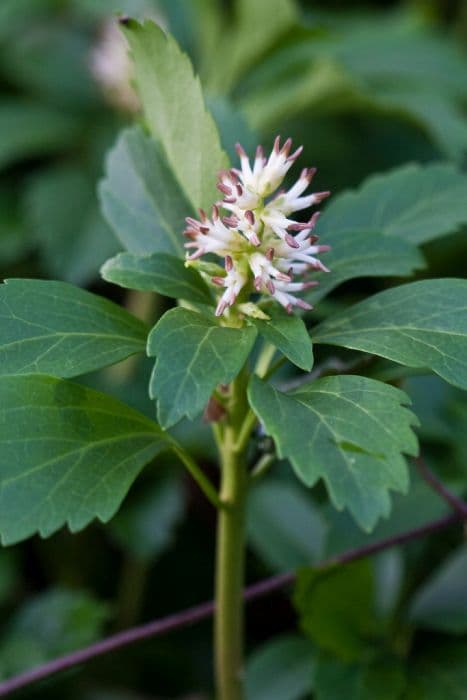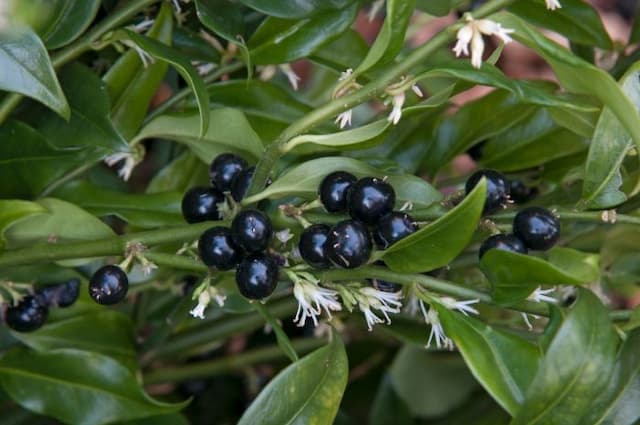Sweetbox Sarcococca ruscifolia var. chinensis 'Dragon Gate'

ABOUT
Dragon Gate is a charming evergreen shrub, renowned for its glossy green leaves that provide year-round interest. The foliage is dense and consists of pointed, elliptical leaves that often have a slightly rippled texture, adding subtle elegance to its appearance. Its stems maintain a graceful form, branching out to create a bushy structure. The standout feature of Dragon Gate is its small yet highly fragrant flowers, which bloom usually in the depths of winter, when few other plants dare to display their charms. These blossoms are tiny, with a creamy white color, arranged in clusters that nestle among the leaves, providing a stark contrast to the dark foliage and a feast for the senses on a cold winter's day. Following the blooming period, this beautiful shrub showcases small, glossy berries. They typically acquire a rich, deep tone as they mature, adding another layer of visual appeal to the plant. Dragon Gate adds an allure to any garden, providing a lush, evergreen backdrop that can complement a myriad of other plantings. Its aromatic presence and seasonal changes in color with flowers and berries make it an attractive choice for those wishing to add both structure and sensory delights to their garden tapestry.
About this plant
 Names
NamesFamily
Buxaceae
Synonyms
Dragon Gate Sweet Box, Chinese Sweet Box
Common names
Sarcococca ruscifolia f. chinensis, Sarcococca ruscifolia var. chinensis.
 Toxicity
ToxicityTo humans
Sweet Box is not commonly known to be poisonous to humans. However, it is always wise to handle garden plants with care and avoid ingesting any parts of ornamental plants, as some individuals may have sensitivity or allergic reactions to certain plant species that are not widely recognized as toxic. If you suspect poisoning after consuming any part of the Sweet Box, seek medical attention promptly.
To pets
Sweet Box is not commonly known to be poisonous to pets. However, as with humans, individual animals might have sensitivities, and it is best to prevent pets from ingesting plants that are not intended for consumption. If a pet shows signs of illness after ingestion of any part of the Sweet Box, including vomiting, diarrhea, or unusual behavior, it is important to contact a veterinarian as soon as possible.
 Characteristics
CharacteristicsLife cycle
Perennials
Foliage type
Evergreen
Color of leaves
Green
Flower color
White
Height
2-3 feet (0.6-0.9 meters)
Spread
2-3 feet (0.6-0.9 meters)
Plant type
Shrub
Hardiness zones
7
Native area
China
Benefits
 General Benefits
General Benefits- Year-Round Interest - Retains its glossy green leaves throughout the seasons, providing constant visual appeal in the landscape.
- Fragrant Flowers - Produces small but highly fragrant flowers, typically in late winter, offering a pleasant scent during a time when few other plants are in bloom.
- Low Maintenance - Requires minimal care once established, making it a good choice for gardeners of all skill levels.
- Shade Tolerance - Grows well in partial to full shade, making it a versatile plant for various garden locations where other plants might struggle.
- Drought Resistance - Once established, it has good drought tolerance, reducing the need for frequent watering.
- Wildlife Attraction - The flowers can attract pollinators such as bees, while the berries provide food for birds.
- Compact Growth - Its relatively compact growth habit makes it suitable for smaller gardens or as understory planting in larger landscapes.
- Evergreen Structure - As an evergreen, it provides structure and color to gardens even in the dormant winter months.
- Erosion Control - Can be used on slopes or areas where erosion control is needed due to its spreading and rooting tendencies.
- Boundary Definition - Ideal for use in hedges or as a natural border due to its dense and bushy growth.
 Medical Properties
Medical PropertiesThis plant is not used for medical purposes.
 Air-purifying Qualities
Air-purifying QualitiesThis plant is not specifically known for air purifying qualities.
 Other Uses
Other Uses- Sarcococca ruscifolia 'Dragon Gate' can be used as a low hedge for bordering walkways or garden paths, providing a neat, evergreen boundary throughout the year.
- It is suitable for planting in outdoor containers, offering year-round foliage interest and fragrant flowers to patios, balconies, or terraces.
- Due to its compact growth habit, 'Dragon Gate' is an excellent candidate for topiary, allowing gardeners to shape it into various forms for decorative purposes.
- The plant's berries can be used in dried floral arrangements, providing a touch of natural color and texture to the composition.
- The dense foliage of Sarcococca ruscifolia 'Dragon Gate' makes it an ideal nesting site for small garden birds, offering them shelter and protection.
- Its resistance to urban pollution makes it a suitable choice for planting in city gardens or as street-side shrubbery where other plants might struggle to survive.
- As a ground cover plant in shaded areas, it can help prevent soil erosion by stabilizing the ground with its root system.
- The glossy leaves can be used in horticultural therapy practices, such as making leaf rubbings or as material for sensory garden experiences.
- 'Dragon Gate' can also play a role in religious or ceremonial decorations, as its evergreen nature symbolizes renewal and eternal life in certain cultures.
- In educational settings, this plant serves as an excellent example to teach about evergreen plants and scent production in flora during the winter season.
Interesting Facts
 Feng Shui
Feng ShuiThe plant Sweet Box is not used in Feng Shui practice.
 Zodiac Sign Compitability
Zodiac Sign CompitabilityThe plant Sweet Box is not used in astrology practice.
 Plant Symbolism
Plant Symbolism- Protection: Sarcococca, commonly known as Sweet Box, is often associated with protection due to its dense evergreen foliage which provides shelter all year round.
- Purity: The white flowers of Sweet Box symbolize purity and cleanliness, reflecting the plant's ability to thrive in shade, suggesting an untainted growth in darkness.
- Hope: The early blooming nature of Sweet Box, sometimes even in winter, represents hope and the promise of spring and renewal.
 Water
WaterSweet Box should be watered regularly to maintain moist but not waterlogged soil, particularly during dry spells. It's best to use deep watering techniques, allowing the water to reach the root zone. This typically means providing about 1-2 gallons of water per week, depending on the weather and soil drainage. However, during the winter months, Sweet Box will require less water; cut back to 1 gallon every two weeks or when the soil feels dry to the touch.
 Light
LightSweet Box thrives best in partial to full shade. It should be planted in a spot where it is shielded from the hot afternoon sun, as this can cause leaf scorch. Ideal locations include north-facing sites or under the dappled shade of trees where the plant can receive filtered sunlight.
 Temperature
TemperatureSweet Box is cold-hardy and performs well within a temperature range of 60 to 70 degrees Fahrenheit but can tolerate temperatures down to around 0 degrees Fahrenheit. To prevent cold damage, avoid planting in open, windy areas where it might be exposed to severe frosts; instead, choose sheltered locations.
 Pruning
PruningPrune Sweet Box to remove any dead or diseased wood and to maintain its desired shape. This is best done in late winter or early spring before new growth starts. Sweet Box does not require heavy pruning; a light trimming every couple of years should be sufficient to keep the plant looking tidy.
 Cleaning
CleaningAs needed
 Soil
SoilFor Sweet Box, the best soil mix is well-draining, rich in organic matter, and slightly acidic to neutral with a pH of 5.5 to 7. A mixture of two parts garden soil, one part perlite or coarse sand, and one part compost or well-rotted manure will create a favorable environment for this plant.
 Repotting
RepottingSweet Box should be repotted every 2 to 3 years, or when it becomes root-bound. It's best to repot in early spring before new growth starts.
 Humidity & Misting
Humidity & MistingSweet Box thrives in moderate to high humidity levels, ideally between 40% to 60%, which mimics its native understory conditions.
 Suitable locations
Suitable locationsIndoor
Place Sweet Box near a window, in filtered light, and keep moist.
Outdoor
Plant Sweet Box in part shade, sheltered from hot sun.
Hardiness zone
7-9 USDA
 Life cycle
Life cycleSarcococca ruscifolia var. chinensis 'Dragon Gate', commonly known as Sweetbox or 'Dragon Gate', begins its life as a seed, which germinates in moist, well-drained soil during spring. The seedling develops into a young plant with a deep root system and starts to grow glossy, evergreen leaves in a slow, clumping fashion. As the plant matures, it forms a dense, shrubby habit, typically reaching up to 2-3 feet tall with a similar spread. During late winter to early spring, the mature Sweetbox produces small, highly fragrant, white flowers that are followed by red berries that turn to black upon maturity – these berries may also serve as a means for propagation, as birds disperse them. The plant has a perennial life cycle and can live for many years, generally requiring little maintenance beyond some light pruning to shape or remove damaged parts. In optimal conditions, Sweetbox will continue to grow and spread, potentially creating a dense ground cover or an attractive feature in a shaded garden spot.
 Propogation
PropogationPropogation time
Early Spring
The most popular method for propagating Sweet Box, particularly the Sarcococca ruscifolia var. chinensis 'Dragon Gate', is through semi-hardwood cuttings. This process usually takes place during the latter part of summer. To begin, cuttings of 4 to 6 inches (about 10 to 15 cm) are taken from a healthy parent plant, ensuring each has several leaf nodes. The lower leaves are stripped off, and the base of the cutting is often treated with a rooting hormone to encourage growth. The prepared cuttings are then inserted into a pot filled with a moist, well-draining potting mix and kept under indirect light. Maintaining a warm environment and high humidity by covering the pot with a plastic bag or placing it in a greenhouse can enhance rooting success. Roots typically develop within a few weeks, after which the new plants can be gradually acclimatized to outdoor conditions before transplanting.




